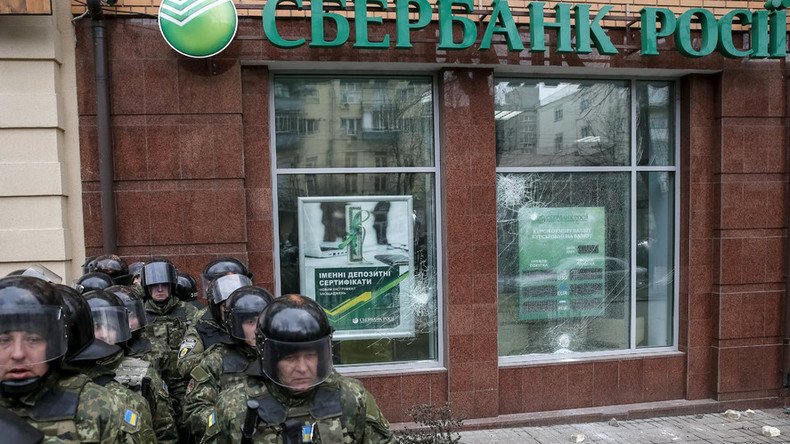Ukrainian radicals trash offices of Russian banks on anniversary of Maidan protests

Ukrainian radicals wrecked the offices of Russian companies Sberbank and Alfa-Bank in Kiev as they marked the second anniversary of the bloody Euromaidan riots, which left around 100 dead and led to major unrest in the country.
The angry mob accused the Russian banks of “financial occupation of Ukraine,” throwing rocks and other foreign objects at the buildings and shattering their windows.
Активісти кидають каміння в "Сбербанк России" pic.twitter.com/4AYPtfUUf5
— Hromadske.TV (@HromadskeTV) 20 февраля 2016
The police prevented the radicals from setting the Sberbank office doors on fire, but the attackers managed to get inside the Alfa-Bank office.
They trashed the furniture and glass partition walls inside the bank, shouting nationalist slogans, including: “Glory to Ukraine! Glory to heroes!”
The offices of the eastern Ukrainian oligarch, Renat Akhmetov, were also attacked in the capital on the same day.
Many of the protestors were wearing balaclavas and camouflaged uniforms with the insignia of the radical Right Sector movement, recently branded “illegal” by Ukraine’s Judge Advocate General.
READ MORE: Ukraine’s Right Sector volunteer battalion is illegal – Judge Advocate General
Members of the volunteer battalions which participated in Kiev’s military campaign in East Ukraine, activists from the far-right Ukrainian Insurgent Army (UPA), and other radical groups were also among those responsible for the violence.
According to LifeNews, Ukrainian security forces have not made a single arrest in connection with the attacks on the Russian banks.
Later on Saturday, several dozen camouflaged man arrived at Maidan Square (also known as Independence Square) in central Kiev, which was the venue for the 2014 protest.
They identified themselves as representatives of the “revolutionary right forces staff” and read out a manifesto in which they demanded the resignation of the government, the reversal of the Minsk peace agreements, and the release of unspecified political prisoners.
The demonstrators also called for an indefinite protest on the Maidan, proclaiming that “we won’t leave until this criminal regime leave,” RIA-Novosti reported.
The radicals were the driving force of the February 2014 coup, which brought the current Ukrainian government to power.
However, the nationalists soon became a liability for the authorities as they considered themselves to be above the law and refused to disarm.
The radicals, on their part, threatened to remove President Poroshenko from power, blaming him and his ministers for being weak and corrupt.
Poroshenko and his family visited the Mikhailovsky Cathedral in the capital on Saturday to take part in the memorial service dedicated to the protesters killed on the Maidan two years ago, known as “the heavenly hundred.”
The Maidan anniversary was also marred in the port city of Odessa as scuffles broke out between supporters and opponents of the coup.
In May 2014 the city saw one of the most horrific manifestations of violence outside of the warzone in Donbass, as 48 anti-Maidan activists were burnt alive by radicals in the local Trade Unions’ House.
On November 21, 2013, thousands gathered on Kiev’s Maidan Square after then-President Viktor Yanukovich decided to postpone the signing of an association agreement with the European Union.
The protests lasted for several months and culminated in heavy violence in February 2014, which forced Yanukovich to flee the country and saw 20 police officers and over 100 protesters killed.
February 20, 2014, was the bloodiest day of riots as unidentified snipers started shooting on both protestors and security forces.
The coup in Kiev resulted in the Republic of Crimea withdrawing from Ukraine to join Russia, and provoked a conflict in the country’s southeast in which almost 8,000 people have died, according to the UN.












